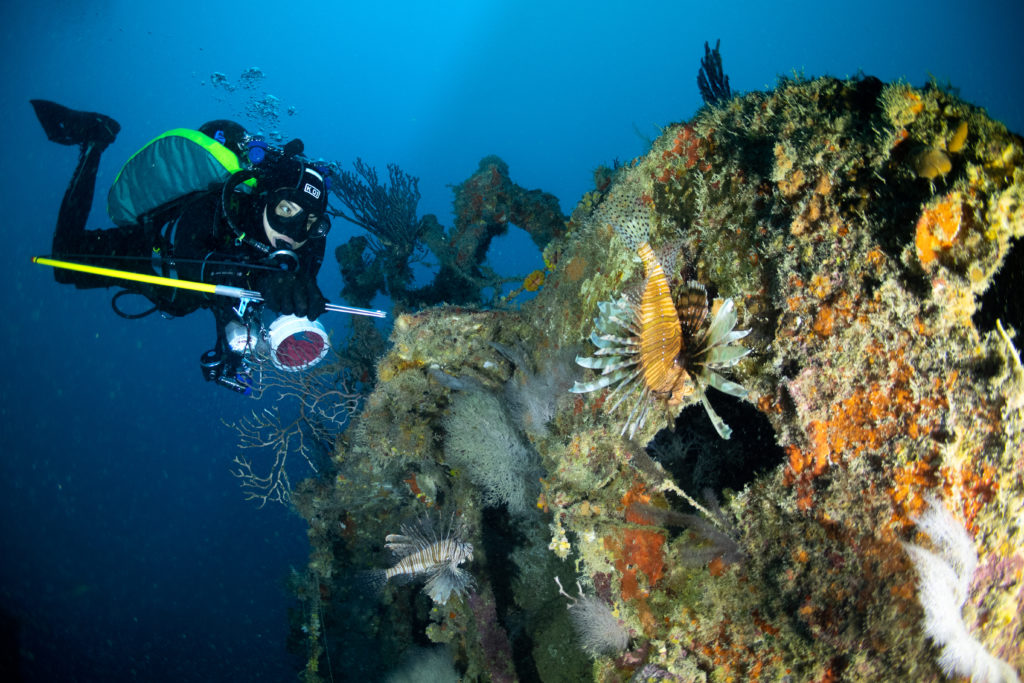Lionfish eat too much. The puffy, colorful carnivores will suck up any fish small enough to fit in their mouths. If a lionfish moves into a coral reef, it quickly eats all of its inhabitants. And then there’s the concern with breeding: A female can lay up to 2 million eggs a year. Natural predators check the tropical fish’s numbers in its native Indian and South Pacific Oceans, but those eating and mating habits are disastrous where they don’t belong. A single lionfish living on a coral reef can reduce the population of native fish by 79% in just five weeks, according to researchers.
That’s what’s happening in the Gulf of Mexico, Atlantic Ocean and Caribbean Sea, where lionfish have been running amok, becoming one of the most devastating invasive species in the United States in the past 30 years. But the fish are also delicious, and eating them might be the best way to control their populations. Salatino Seafood is trying to make it easier for American chefs and diners to fill their plates for the good of our oceans. “Eating this fish is beyond sustainable. It’s a net positive,” Roland Salatino, who founded the company with fellow former consultant Aarav Chavda, says. The pair had been diving off the coast of Florida together for years and had witnessed firsthand the booming population of lionfish and its degrading effects on the state’s extensive reef system. They founded Salatino Seafood on Sanibel in 2020 to act as a broker between the divers catching the fish and the chefs serving it, singlehandedly creating a stable market for the seafood. “We want to give divers incentive to get in the water, so they want to hunt lionfish instead of our native grouper,” Salatino says. He has increased the market price for large lionfish from $4 per pound to $6.50 per pound to motivate spearfishers.“Every time you eat lionfish at a restaurant, you’re helping our planet recover.”
The history of the lionfish in our oceans is a little murky. They were first documented off the coast of Florida in 1985. Experts believe the popular aquarium species were introduced when a few tank owners, tired of feeding the voracious eaters, released them into the ocean. Our warm waters and ample food supply helped them thrive. “The meteor that killed the dinosaurs wiped out 75% of species globally. Lionfish are wiping out almost 80% on a reef-by-reef basis,” Salatino says. Reflecting on the effects of overfishing on popular seafood species, like salmon, which are on the brink of elimination in certain areas, he started wondering if fishing patterns could positively benefit the issue of invasive lionfish. “Think about what our appetites have done with salmon or tuna populations,” he says. “Why can’t we turn that consumer machine onto something that doesn’t belong?”
But seafood lovers have been slow to respond to this particular fish, partly because of its venomous spines, which create a misconception among diners that the meat is poisonous, and partly because the fillets aren’t common on restaurant menus or in seafood shops. Lionfish isn’t an easy catch: They won’t bite a hook and can’t be caught with nets because they live on reefs. You have to dive and hunt them with pole spears, which limits the number of people who can actively remove them from the ocean since there are far fewer divers than fishers. Lionfish are slow moving and therefore easy to spear, but divers have to get around the fish’s natural defense mechanism: 18 venomous spines.“I’ve been hit by one of those spines, and it’s one of the worst pains I’ve ever felt,” Danielle Pierone, who caught roughly 200 pounds of lionfish for Salatino in the last six months, says. She studied the impact of lionfish on reef systems while at Penn State University and has been hunting them steadily for the past six years. “Each one you take out, you’re stopping thousands more from being born,” she says.
Pierone estimates that 15% of divers in Florida are actively targeting the species. The Florida Fish and Wildlife Conservation Commission hosts regular lionfish derbies where prize money is awarded in different categories, as well as a summerlong Lionfish Challenge with commercial and recreational divers competing to see who can haul in the most (last year’s winner caught 1,632). The commission also sponsors an annual Lionfish Removal and Awareness Day this month. Salatino Seafood sees an uptick in commercial divers who target lionfish, and they’re encouraging the practice with a new training program that equips and teaches divers to hunt the species safely.
Processing is also problematic, and there hasn’t been a good system to harvest lionfish for restaurants at a large enough scale to be impactful. Chefs rave about the fish’s utility and have been preparing it in a variety of ways, from sashimi to stews. And even though lionfish are venomous, eating them is perfectly safe. The venom is contained within the spines, which are removed during the filet process, and the meat is low in mercury. Harold Balink, chef and owner of Harold’s in Fort Myers, likes to let the fish speak for itself in his dishes, using citrus and herbs to enhance the flavor without masking it. “I describe to people at the restaurant that it’s similar to hogfish,” he says. “It’s not as sweet. The fillets are a little more delicate but very white, light and flaky.”
He’s served lionfish at his restaurants for years but has found it hard to keep on the menu due to the burden of processing them. “Lionfish is a pain in the butt to clean because of the spines and the small size of the fish, so it’s not cost-effective to pay someone $20 an hour to cut up a few ounces of fillet,” Balink says.
Enter Salatino Seafood, which handles all of the prep chefs can’t afford to do in their own kitchens. Salatino purchases the fish whole from divers and transports the catch on ice to its processing facilities in Destin and Tampa, where trained employees remove the skins and fillet the fish. Antivenom is on hand, but the risk of serious injury is low. “It’ll hurt,” Salatino says of the spines. “But you can get a lot worse done to you by a bacterially contaminated snapper spine.”
The fish is then individually quick frozen and delivered or shipped to restaurants in Florida and beyond, as far south as Aruba and as far north as New York City. According to Balink, this is an integral step toward getting more lionfish in front of American diners. In just two years, Salatino has become the largest lionfish buyer and distributor in Florida. Last year, its divers removed an estimated 10,000 lionfish from our waters. This year, they’re hoping to double their catch. Harold’s is a consistent client, and The Sanctuary on Sanibel Island and the Captiva Island Yacht Club have also featured Salatino’s lionfish.
Salatino and Chavda have also expanded their business beyond filets, debuting lionfish leather under the brand, Inversa Leathers. Lionfish skin is incredibly durable and strong, making it an ideal substitute for cowhide.
Their efforts are making a difference. Perione says most of the shallow reefs she sees close to shore are now devoid of lionfish, which have moved to deeper reefs and wrecks where recreational divers are less apt to hunt. Although it’s preferable to see the lionfish moving into concentrated areas instead of ravishing reefs up and down the coast, having them move into deeper reefs that are harder to hunt is problematic, too; engineers are working on lionfish traps that could be set in areas that recreational divers can’t reach. Still, seeing the lionfish abandon the hunted reefs shows that actively pursuing this species can have a positive impact. “We can’t eliminate the lionfish population entirely. They breed too fast,” Salatino says. “But we can eat enough of them to get them below an impact level, so the local species can bounce back. That’s the goal.”




